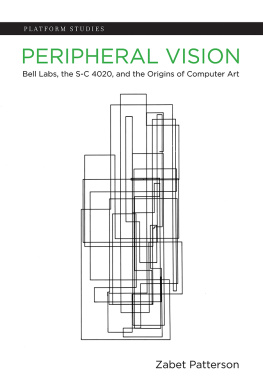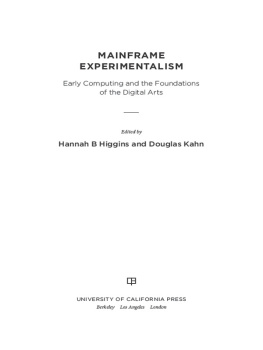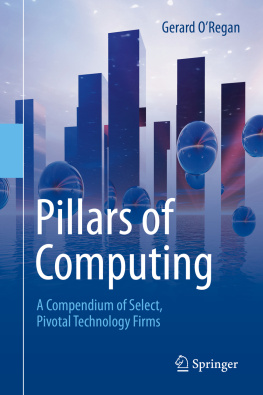Peripheral Vision
Platform Studies
Nick Montfort
Ian Bogost
Racing the Beam: The Atari Video Computer System , Nick Montfort and Ian Bogost, 2009
Codename Revolution: The Nintendo Wii Platform, Steven E. Jones and George K. Thiruvathukal, 2012
The Future Was Here: The Commodore Amiga, Jimmy Maher, 2012
Flash: Building the Interactive Web, Anastasia Salter and John Murray, 2014
Positive Computing: Technology for a Better World, Rafael A. Calvo and Dorian Peters, 2014
I AM ERROR: The Famicom / Nintendo Entertainment System Platform, Nathan Altice, 2015
Peripheral Vision: Bell Labs, the S-C 4020, and the Origins of Computer Art, Zabet Patterson, 2015
Peripheral Vision
Bell Labs, the S-C 4020, and the Origins of Computer Art
Zabet Patterson
The MIT Press
Cambridge, Massachusetts
London, England
2015 Massachusetts Institute of Technology
All rights reserved. No part of this book may be reproduced in any form by any electronic or mechanical means (including photocopying, recording, or information storage and retrieval) without permission in writing from the publisher.
Library of Congress Cataloging-in-Publication Data
Patterson, Zabet.
Peripheral vision : Bell Labs, the S-C 4020 and the origins of computer art / Zabet Patterson. pages cm. (Platform studies)
p. cm.
Includes bibliographical references and index.
ISBN 978-0-262-02952-0 (hardcover : alk. paper)
ISBN 978-0-262-33007-7 (retail e-book)
1. Computer art. 2. Computer peripherals. 3. AT & T Bell Laboratories. I. Title.
N7433.8.P378 2015
776 dc23
2015002000
d_r0
For A
Series Foreword
How can someone create a breakthrough game for a mobile phone or a compelling work of art for an immersive three-dimensional environment without understanding that the mobile phone and the 3D environment are different sorts of computing platforms? The best game artists, writers, programmers, and designers are well aware of how certain platforms facilitate certain types of computational expression and innovation. Likewise, computer science and engineering have long considered how underlying computing systems can be analyzed and improved. As important as scientific and engineering approaches are and as significant as work by creative artists has been, there is also much to be learned from the sustained, intensive, humanistic study of digital media. We believe it is time for humanists to consider the lowest level of computing systems to understand their relationship to culture and creativity.
The Platform Studies book series has been established to promote the investigation of underlying computing systems and the ways that they enable, constrain, shape, and support the creative work that is done on them. The series investigates the foundations of digital mediathe computing systems, both hardware and software, that developers and users depend on for artistic, literary, and gaming development. Books in the series will vary in their approaches but will share certain features:
A focus on a single platform or a closely related family of platforms,
Technical rigor and in-depth investigation of how computing technologies work, and
An awareness of and discussion of how computing platforms exist in a context of culture and society, being developed based on cultural concepts and then contributing to culture in a variety of waysfor instance, by affecting how people perceive computing.
Acknowledgments
This project first took form at the University of California, Berkeley, in the marvelous interdisciplinary environment that extended there across the departments of Rhetoric and Film Studies, Art History, and Performance Studies. I owe an incredible debt to Kaja Silverman and Shannon Jackson; I can only offer my heartfelt thanks. I am also profoundly grateful to Linda Williams and Greg Niemeyer for their efforts on my behalf. While at Berkeley, I participated in an extraordinary community that shaped my thinking: Patrick Anderson, Scott Combs, Jessica Davies, Meredith Hoy, Homay King, Eve Meltzer, Andrew Moisey, John Muse, Ara Osterweil, Kris Paulson, Domietta Torlasco, and Heather Warren-Crow, among many others, deserve special acknowledgement. At Stony Brook, I have been fortunate to find a home with wonderful colleagues in Art and cDACT.
This book would not have happened without Ian Bogost, who saw the possibilities in this project, and, with Nick Montfort, stewarded it through the initial stages at MIT Press. I am grateful to Doug Sery, and the team of editors at the MIT Press, as well as to the anonymous editors solicited by the MIT Press, whose insightful comments clarified my thinking, and made this a much better piece of work.
My parents have offered years and hours of endless patience and support. Matthew, laughter and learning a little something, always. My extended family has offered love and understanding. But the days, weeks, and minutes have belonged to my smaller family: Perdita, Surya, Maya, and, above all, Andrew.
Introduction
In the late 1950s and 1960s, mainframes dominated computing. Their name came from the large metal frames in which banks of circuits were mounted. They were more architecture than object, and their cost was commensurate. As such, these computers were the exclusive province of governmental military agencies, university research centers, and a few of the largest corporations. Their image in popular culture was of switches and blinking lights, emphasizing that first and foremost they were calculation machineswith no necessary relationship to optical media. In the era of the mainframe, the output of text and image was quite literally peripheral. Companies made a range of special-purpose devices to supplement mainframe computers that did not necessarily ship with screens or printers.
Stromberg-Carlson was one of these manufacturers. In 1954, the US Department of Defense contracted with it to supply a special-purpose mainframe peripheral for the SAGE (Semi-Automatic Ground Environment) computerized air defense systema cathode ray tube (CRT) screen. SAGE was tricked out in firsts: among other things, it famously initiated the coordinated and systemic use of lightguns, duplexing, multiprocessing, modems, and computer networking over telephone lines. Nonetheless, the screen that functioned as a real-time graphical user interface is generally understood to be its most important feature. Manufactured by Stromberg-Carlson, it was the companys first flagship product, and the Defense Department order was its largest to date. The key dilemma for the SAGE designers was the need for highly legible text with a sufficiently rapid refresh rate to allow air force specialists to track aircraft in real time. Stromberg-Carlson engineered a CRT screen called the Charactron. Its shaped beam tube deflected electrons through a mask of alphanumeric characters, transferring these characters to the viewing area at very high resolution with a display rate of ten thousand characters per second.
In 1959, Stromberg-Carlson began manufacturing another mainframe peripheral based on the Charactron screen. This one did not offer real-time interactivity. The S-C 4020 microfilm recorder could be attached to the IBM 7090, 7094, 360, and other existing mainframes to present and preserve images and image sequences in ways that then-contemporary interactive computer screens simply could not. It could produce extraordinarily precise line drawings and text far above the level of pen-based plotters. It was a strange and elaborate apparatus with a tape drive for accepting instructions, a controlling buffer, a Charactron screen sealed in a light-tight compartment with a film camera and a photographic camera, and development equipment for these images. Because the S-C 4020 does not easily fit within linear genealogies of computing that move inexorably toward interactivity and real-time engagement, it has largely fallen off the radar of modern computer histories, despite its central importance as a peripheral for visualization for the mainframe computers of the late 1950s to the mid-1980s. Yet its use during that time was sufficiently widespread to prompt its own user group, its own conferences, and even its own specialized scientific journal. All told, the S-C 4020 produced the majority of the computer graphics of the late 1950s and early 1960s.
Next page










